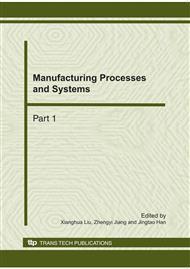p.241
p.245
p.253
p.259
p.267
p.271
p.276
p.280
p.285
Lubricating Characteristics of Circular Tilting Pad Thrust Bearing
Abstract:
In order to solve lubricating problem of circular tilting pad thrust bearing in the heavy equipment, lubricating characteristics mathematical model is established based on the Computational Fluid Dynamics and lubricating theory, the Finite Element Method is used to compute the lubricating characteristics of a circular tilting pad thrust bearing, and figure out thickness distribution of oil film, pressure distribution of oil film, temperature distribution of oil film, power loss and fluid flow, etc. lubricating characteristics parameters by self-compiling software program. Experiments testify the validity of the lubricating characteristics mathematical model. Through this method, the safety of a circular tilting pad thrust bearing can be forecasted, and the optimal design of such products can be achieved, and provides reasonable data for actual design and experiment, and decreases economy loss.
Info:
Periodical:
Pages:
267-270
Citation:
Online since:
October 2010
Price:
Сopyright:
© 2011 Trans Tech Publications Ltd. All Rights Reserved
Share:
Citation:


